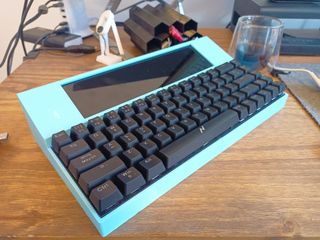Maker Builds Tandy-Inspired, 3D-Printed Cyan Cyberdeck
Powered by Radxa's more powerful Pi Zero W alternative

For the last 16 months, Argentina-based coder and maker Roberto Alsina has been prototyping his own computer. Inspired by the Tandy Model 100, Alsina has created what can only be described as an oddity in a world of clamshell laptops and tablets with keyboards. But the process is just as fascinating as the result.
Alsina had to come up with a way to run the computer, design a case, utilize a power source, install a keyboard and source a screen with a 5:1 aspect ratio.
The computer, which Alsina hasn't named, is running on a Radxa Zero, partially because when he was looking to buy a single-board computer to run his project, it was tough to find a Raspberry Pi in stock or at a reasonable price.
But that Radxa Zero didn't have all of the ports that Alsina wanted, so he plugged a USB hub into its USB 3.0 port, allowing it to power the display, the keyboard and a USB sound card, with jacks exposed through the side of the case (although an issue charging the display required re-working, so now he has an extra USB port).
The keyboard, which Alsina gutted to fit into his case, was a cheap 65% board (he didn't want to give up the arrow keys and I can't blame him) that he found for less than $20.
"It's absolute garbage," he wrote of the keyboard. "The stabilizers are horrible, the switches are scratchy and inconsistently clicky yet loud, and it was perfect for the job because all keyboards in 80s computers were pretty crap."
Alsina's display is a 1920 x 480 screen without touch, because his intention is for this whole thing to be controlled by the keyboard. It ends up that this rare type of screen doesn't necessarily work with all operating systems, and Alsina had to build a custom kernel from Github for it. Getting the screen to connect over HDMi internally required ordering odd cables that took three months to ship. So if you're looking to follow Alsina's instructions, prepare early.
Using a battery pack didn't work for Alsina's design, so he got a "Raspberry Pi UPS" that mounts some 18650 batteries in a case mounted to a circuit board. He had some issues: like the power button didn't turn off all of the power outputs, but it otherwise seems to work.


All of this needed to fit into a case, but Alsina wrote he has no knowledge of 3D design software. Instead, he used CadQuery to develop the models he eventually 3D printed. He put most of the scripts to generate these pieces on his code server.
The "laptop" runs Ubuntu Focal, which requires a custom kernel and a fixed-up dynamic window manager. He's using it with the Alacritty terminal and Falkon web browser. He's used te device to watch a YouTube video, run a "lightweight graphical desktop," write code and text and run apps in the terminal. He says he's getting three to five hours on a charge depending on what he uses it for.
Prototipo rev 2 terminado y funcionando pic.twitter.com/IFOD2h2e7EMarch 2, 2023
"Did I succeed?" Alsina writes. "Hell no. This is janky as hell because it's a handmade prototype, but it shows the seeds of possibility, of iteration that may make it ... possible."
He also has some issues to keep working on. For instance, there's no airflow, so the system overheats, which causes several problems. The keyboard is too high to be uncomfortable, it can slip on a table, and he would like an integrated trackball or a nub for a pointer that doesn't require a mouse.
For far more engineering details, photos of messy wires and specifics on the building process, as well as a surprising amount of humor, check out Roberto Aisna's blog post on his build.
Stay On the Cutting Edge: Get the Tom's Hardware Newsletter
Get Tom's Hardware's best news and in-depth reviews, straight to your inbox.
Andrew E. Freedman is a senior editor at Tom's Hardware focusing on laptops, desktops and gaming. He also keeps up with the latest news. A lover of all things gaming and tech, his previous work has shown up in Tom's Guide, Laptop Mag, Kotaku, PCMag and Complex, among others. Follow him on Threads @FreedmanAE and Mastodon @FreedmanAE.mastodon.social.
Most Popular



